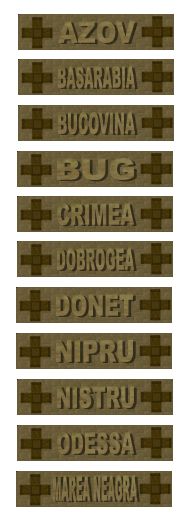Medal in memory of the crusade against communism
The medal commemorating the crusade against communism ( Romanian Medalia comemorativa Cruciada împotriva Comunismului ) is a by on April 1, 1942 King Mihai I of Romania donated by decree number 1014 commemorative medal .
Lender
According to the purpose of the foundation, the medal could be awarded to all participants who were involved in the fight against the Soviet Union in World War II , above all to a large number of members of the German armed forces , but also to Slovak and Hungarian soldiers. The medal was usually awarded in a simple paper medal bag, but also in small red or brown boxes with a white inlay. On the top it read in gold letters: MONETARIA NATIONALA .
Appearance
The round medal made of bronze or non-ferrous metal shows on its front side the head of a woman with long braids, which is turned to the right. The woman depicted is very similar to a picture of Helvetia . A signature P. Grant is embossed underneath . The inscription ROMANIA RECUNOSCATOARE (Romania's gratitude) runs under the bust . On the back, a paw cross is shown in the center, in front of the foreground a sword, clasped by a hand, is stretched into the sky. The sword separates the year 19 41 in the upper cross arm . All around in capital letters + CRUCIADA IMPOTRIVA + COMUNISMULUI (crusade against communism). Due to the large number of manufacturers involved, the diameter of the medal is approx. 31.7 mm and its edge thickness is approx. 2 mm.
Band clips
Combat clips with the designation of the theater of war or the battlefield were awarded to the medal for the fighting troops. For civilians or soldiers from the rear areas, the medal was generally awarded without combat clips. The battle clasps were either made of bronze or silver-plated. The clasps themselves were attached (bent over) to the back of the medal ribbon with two bending tabs attached to the side. Their width varied from 25 mm or 35 mm, depending on the width of the ribbon awarded. So far, 14 braces are known
- AZOV
- BASARABIA
- BUCOVINA
- BUG
- CRIMEA / CRIMEIA
- DOBROGEA
- DONET
- NIPRU
- NISTRU
- ODESSA
- MAREA NEAGRA (from July 16, 1942)
- CAUCAZ (unofficial clasp)
- CALMUCIA (unofficial clasp)
- STALINGRAD (unofficial clasp)
The award of the battle clasp came into question if the entrusted only stayed at one of the combat locations mentioned or was directly involved in combat operations. If the entrusted person was in possession of several clasps, only the clasp from the last battle could be worn, but then in silver-plated design. The cross on the left and right of the clasp has a letter M at each of its four edge points . This letter stands for Mihai I of Romania, the founder of the medal. The decree of the later donated Marea Neagra should be reproduced here in full:
"Michael I, by God's grace and the will of the people, King of Romania, greetings to all present and future. We have decreed and decreed: "
Carrying method
The award was worn on a dark red ribbon with silver side stripes and a ribbed central stripe in the colors blue, yellow, red, the national colors of Romania, on the left side of the chest, on the day after it was awarded only as a field clasp.
Others
From August 23, 1944, the day Romania declared war on the German Reich, the wearing of Romanian decorations was forbidden as a punishment for German Wehrmacht members. According to the law on titles, medals and decorations of July 26, 1957 (Section 6, Paragraph 1, Item 4), awards from former allied countries may continue to be worn during World War II .
See also
literature
- Kurt-Gerhard Klietmann : Phaleristics. Volume 1: Romania. The Order Collection, Berlin 1975, ISBN 3-87778-400-3 .
- Kurt-Gerhard Klietmann: Pour le Merite and Medal of Bravery. The Order Collection, Berlin 1966.
- David Littlejohn: Foreign Legions of the Third Reich. Volume 4: Poland, the Ukraine, Bulgaria, Rumania, Free India, Estonic, Latvia, Lithuania, Finland and Russia. Bender, San José CA 1987.



